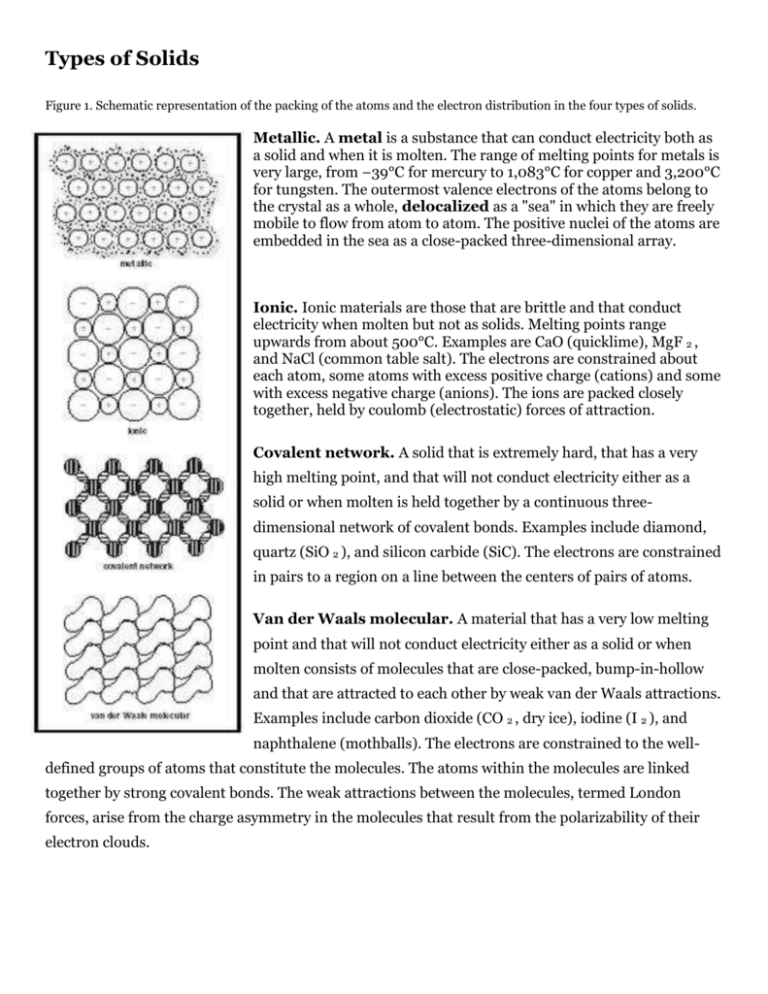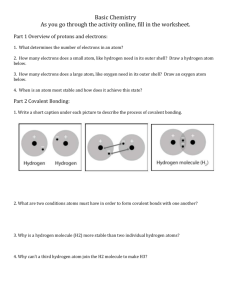File - Ms. Henderson`s Chemistry Class James Campbell
advertisement

Types of Solids Figure 1. Schematic representation of the packing of the atoms and the electron distribution in the four types of solids. Metallic. A metal is a substance that can conduct electricity both as a solid and when it is molten. The range of melting points for metals is very large, from −39°C for mercury to 1,083°C for copper and 3,200°C for tungsten. The outermost valence electrons of the atoms belong to the crystal as a whole, delocalized as a "sea" in which they are freely mobile to flow from atom to atom. The positive nuclei of the atoms are embedded in the sea as a close-packed three-dimensional array. Ionic. Ionic materials are those that are brittle and that conduct electricity when molten but not as solids. Melting points range upwards from about 500°C. Examples are CaO (quicklime), MgF 2 , and NaCl (common table salt). The electrons are constrained about each atom, some atoms with excess positive charge (cations) and some with excess negative charge (anions). The ions are packed closely together, held by coulomb (electrostatic) forces of attraction. Covalent network. A solid that is extremely hard, that has a very high melting point, and that will not conduct electricity either as a solid or when molten is held together by a continuous threedimensional network of covalent bonds. Examples include diamond, quartz (SiO 2 ), and silicon carbide (SiC). The electrons are constrained in pairs to a region on a line between the centers of pairs of atoms. Van der Waals molecular. A material that has a very low melting point and that will not conduct electricity either as a solid or when molten consists of molecules that are close-packed, bump-in-hollow and that are attracted to each other by weak van der Waals attractions. Examples include carbon dioxide (CO 2 , dry ice), iodine (I 2 ), and naphthalene (mothballs). The electrons are constrained to the welldefined groups of atoms that constitute the molecules. The atoms within the molecules are linked together by strong covalent bonds. The weak attractions between the molecules, termed London forces, arise from the charge asymmetry in the molecules that result from the polarizability of their electron clouds. Metallic Bonding: How metals conduct electricity in solid state.Metals are unique in that they can conduct electric current in the solid state. (Examples include aluminum high voltage transmission cables and copper wire in domestic wiring.) Also, metals are ductile and malleable; they can be hammered into sheets, such as the pressed steel used as body parts for a car. The layers of atoms can slide past each other on a cushion of electrons, yet the solid remains whole. (See Figure 1.) Figure 2. The tetrahedron of bonding types. Typical examples are: metallic-copper; ionic-NaCL; covalent network-diamond; van der Waals, molecular-iodine. Hydrogen bonding would be represented by the cross-hatched area near to van der Waals types of bonding. Ionic Bonding When two elements of very different groups in the Periodic Table react (e.g., the metals Na and Mg from Groups 1 and 2 on the left side with the nonmetals O 2 and Cl 2 from Groups 6 and 7 on the right side), the product is a solid (usually colorless) that has a high melting point. The product is an insulator but will conduct electricity in the molten state. The solid is built of alternating positively charged cations and negatively charged anions, packed tightly together. In figure 3, the Figure 3. Face-centered cubic structure of NaCl and small spheres represent the cations, and the large spheres MgO crystals. represent the anions. [Remember, cations are smaller than anions because anions have more electrons and because of electron shielding (which occurs when there are a greater number of electrons) the electrons are less closely attracted to the nucleus, causing the atomic radius to be bigger.] Covalent Bonding This type of bonding is found between pairs of similar atoms, especially among those in the upper right hand corner of the periodic table. For example, C–C in hydrocarbons, S–O in sulfur dioxide, C– F in Freons. The bonds can give rise to three-dimensional structures like diamond, and are found in simple molecules like H 2 S. These bonds are strong, and result in molecules with fixed geometry, such as methane, and give rise to optical activity in molecules such as lactic acid where the C atom is rigidly bonded to four different groups. Pairs of electrons. Covalent bonding occurs between two atoms as a result of the sharing of a pair of electrons between the atoms. An example is provided in Figure 4. Octets and Lewis Structures When bonded, atoms of the elements C, N, O, and F always tend to be associated with eight electrons in the valence shell—the "octet." The simultaneous attaining of a pair of electrons per covalent bond and an octet around the heavy atom is a powerful bookkeeping method of accounting for the bonding in molecules of the lighter main group elements in the periodic table. The diagrams are termed Lewis structures. The three-dimensional network structures are built around atoms with four bonds in a tetrahedron. For example, in diamond each carbon atom shares electrons with four neighbors to give four covalent bonds in a tetrahedral array. (See Figure 5.) Ammonia methane Figure 5. Octet of electrons about the carbon atom in diamond. Each straight line represents a localized two-center two-electron bond. In the ammonia molecule, one pair of electrons on the nitrogen atom is not involved in directly bonding to the H atoms; this is termed a lone pair. If we apply the Lewis formalism to the diatomic molecules of nitrogen, oxygen, and fluorine, we get N≡N, a triple bond O=O, a double bond F—F, a single bond Van der Waals Attractions Materials held together by van der Waals attractions often have a smell at room temperature (e.g., camphor and menthol). This is caused by the molecules escaping from the solid and subliming directly into the gas phase . The attractive forces between the molecules are weak. These forces arise from distortions in the electron cloudaround the molecule, which cause some parts to be relatively positively charged, while other parts are relatively negative. Real Life Examples: Van der Waals attractions are what allow geckos’ feet to stick to what they’re climbing. Polar bonds. When a covalent (electron pair) bond is formed between two different atoms, the pair of electrons is concentrated nearer the atom with the larger power to attract electrons. This power is termed electronegativity. Depending on its shape, the molecule as a whole can have a dipole moment μ . Polarizability. More interestingly, neutral molecules with a zero dipole moment are mutually attracted to give liquids (such as CCl 4 ) and solids (such as naphthalene). These attractions, termed London forces or dispersion forces, arise from the ease of distortion of the electron cloud of the molecule as a whole. This is termed polarizability and is related to the volume of the molecule and the number of electrons in the valence shells of the atoms on the exposed surface of the molecule. The net effect (surprisingly, perhaps) is large and accounts for the relatively high melting points of iodine, CO 2 (dry ice), and naphthalene. These London forces are important; they are the attractions between the long-chain polymeric molecules in solid polyvinyl chloride (PVC) and polyethylene. Hydrogen bonding . The effect of polarity of a covalent bond is magnified in the case of a hydrogen atom bonded to an atom of either fluorine, oxygen, or nitrogen. In simple molecules, the distortion of the electron cloud is large, causing the hydrogen atoms to be slightly positively charged. For instance, This results in a strong attraction between pairs of molecules: Alloys. Many alloys have structures in which the atoms of the different metals are ordered. Hence they behave like compounds (e.g., AuCu 3 and Cu 5 Zn 8 ). CsAu has the NaCl structure (see Figure 3) and behaves almost as if it were ionic, Cs + Au − . This corresponds with the low ionization energy of Cs, 376 kilojoules per mole, and the favorable electron affinity of Au, 223 kilojoules per mole. CsAu's bonding would lie along the metal/ionic edge of the tetrahedron of bonding types. Semiconductors. Semiconducting materials are of great practical importance in electronics. Ge, GaAs, ZnSe, and CuBr, are examples and they have bonding that can be described as intermediate between ideal covalent and ideal ionic. Each atom is bonded to four others in a tetrahedron, the zinc blende structure. Silicate minerals. The bonding within a solid is always reflected in its physical properties, and this relationship to its internal structure is beautifully displayed in the morphology of the series of silicate minerals: quartz, mica, and asbestos. In quartz there is a three-dimensional network of Si—O bonds. In mica there are negatively charged infinite sheets consisting of a two-dimensional network of SiO 4 units, with the sheets linked by cations. In asbestos, there are infinite negatively charged chains of tetrahedral SiO 4 units with strong covalent Si—O—Si bonds. The chains are attached to each other via cations. These latter two solids are each held together by two types of bonds, and the difference between the very strong covalent bonding and the other weaker attractions is evident. Mica is easily split into sheets, whereas asbestos consists of fibers. Glass. Ordinary glass is an amorphous solid, constructed of negatively charged fragments of nets of SiO 4 units that are linked by Na + and Ca 2+ cations. There is no internal order. As a result, glass shatters to give curved surfaces; and it gradually softens on heating and does not have a sharp melting point. The bonding in ceramic materials (such as bricks, tiles, pottery, and insulators) is similar, predominantly ionic. Conclusion It is important to remember that bonding is always accompanied by a reduction in energy, and that all bonding theory is but an intellectual model, a mental scaffolding on an atomic scale, on which to hang our ideas in hopes of giving a self-consistent explanation of observed reality. SEE ALSO Molecular Orbital Theory ; Valence Bond Theory . Michael Laing Bibliography Adams, D. M. (1974). Inorganic Solids. London: John Wiley & Sons. Brady, James E.; Russell, Joel W.; and Holum, John R. (2000). Chemistry , 3rd edition. New York: John Wiley & Sons. Brown, Theodore L.; Le May, H. Eugene; and Bursten, Bruce E. (2000). Chemistry , 8th edition. New Jersey: Prentice Hall. de Kock, Roger L., and Gray, Harry B. (1980). Chemical Structure and Bonding. Menlo Park, CA: Benjamin/Cummings Publishing Co. Huheey, James E.; Keiter, Ellen A.; and Keiter, Richard L. (1993). Inorganic Chemistry , 4th edition. New York: Harper Collins. Ketelaar, J. A. A. (1958). Chemical Constitution , 2nd edition. Amsterdam, Netherlands: Elsevier. Olmsted, John, and Williams, Gregory M. (2002). Chemistry , 3rd edition. New York: John Wiley & Sons. Pauling, Linus (1960). The Nature of the Chemical Bond. Ithaca, NY: Cornell University Press. Read more: http://www.chemistryexplained.com/Bo-Ce/Bonding.html#ixzz3TMO3C07A








